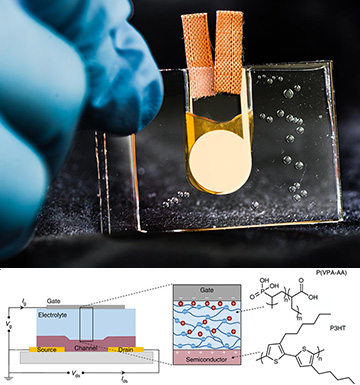
The Linköping researchers’ prototype device (top) and schematic of the electrolyte-gated transistor (bottom). [Images: Thor Balkhed; Zhao et al., Nat. Commun., doi: 10.1038/ncomms14214]
Researchers at Linköping University, Sweden, have reported what they say is the first demonstration of a low-voltage, heat-gated organic transistor, a device that converts modulations in temperature gradient to modulations in electric drain current (Nat. Commun., doi: 10.1038/ncomms14214). The team believes that the device—the temperature-sensing amplification of which is, according to the study, “thousands of times superior to that of a single thermoelectric leg in traditional thermopiles”—could have “important applications” in the realm of infrared photonic devices, including smart temperature sensors, inexpensive thermal cameras and improved heat-sensing electronic skins.
Pyroelectrics and thermoelectrics
Devices that tie heat to electrical signals are, of course, legion in today’s world, spanning the gamut from infrared sensors and thermal cameras to medical thermal imaging systems and diagnostics. Such devices typically rely on pyroelectric sensors (such as motion sensors), which measure transient changes in incident infrared radiation, or thermoelectric materials, in which the motion of charge carriers within the material under a temperature gradient produces a voltage proportional to the temperature gradient (V = SΔT).
But these approaches both have their disadvantages. Pyroelectric sensors do not serve well for static temperature measurement, and can be sensitive to vibrations. And thermoelectric sensors have tended to have sensitivity limits, as the proportionality constant between temperature and voltage—the so-called Seebeck coefficient, S—tends to be low in many conventional thermoelectric materials. That means that very small temperature gradients produce only very weak voltage signals.
Toward a heat-gated device
To get around these disadvantages, the Linköping team, headed up by Xavier Crispin, looked at the possibility of using temperature gradient as a parameter directly to control a logic gate—that is, at creating a low-voltage transistor in which a temperature gradient would take the place of the usual electric bias current to control the output current. Such a scheme would allow, in principle, significant amplification and a sensitivity boost relative to conventional thermoelectric materials.
To create such a heat-gated transistor, the researchers built on their previous work in developing ionic thermoelectric supercapacitors (ITESCs) based on liquid electrolytes. These electrolytes, because of their high charge mobility, can achieve high Seebeck coefficients, making them a potentially good foundation for a thermally sensitive device that could operate at low voltages.
Sensitivity advantage
The team built its organic transistor prototype by sandwiching a layer of electrolyte between a top metal gate electrode and a bottom semiconducting polymer layer, itself tied to source and drain electrodes. The researchers then connected a thermoelectric voltage generator based on their previously developed ITESCs to the source and gate electrodes.
Because of the high Seebeck coefficient of the ITESCs, the team found that a small temperature gradient applied to the single ITESC voltage generator allowed sufficient voltage to switch the low-voltage organic-transistor side of the setup. That constitutes a big sensitivity advantage, according to the research team; with traditional thermoelectric materials, they say, 100 such “thermoelectric legs” would be required to achieve the same gating effect.
According to the Linköping researchers, the work marks the first demonstration that a “heat signal can act as input for logic circuits,” a result that they suggest points to a new field of “thermoelectronics.” And, while the setup involved direct contact heating, they stress that the concept “would also hold for heating through infrared radiation, thus positioning our finding in the field of infrared photonics.” The study particularly cites “applications in thermometry, thermography, smart sensors, human-organic electronic technology interfacing (that is, e-skin) and active flexible electronics.”
